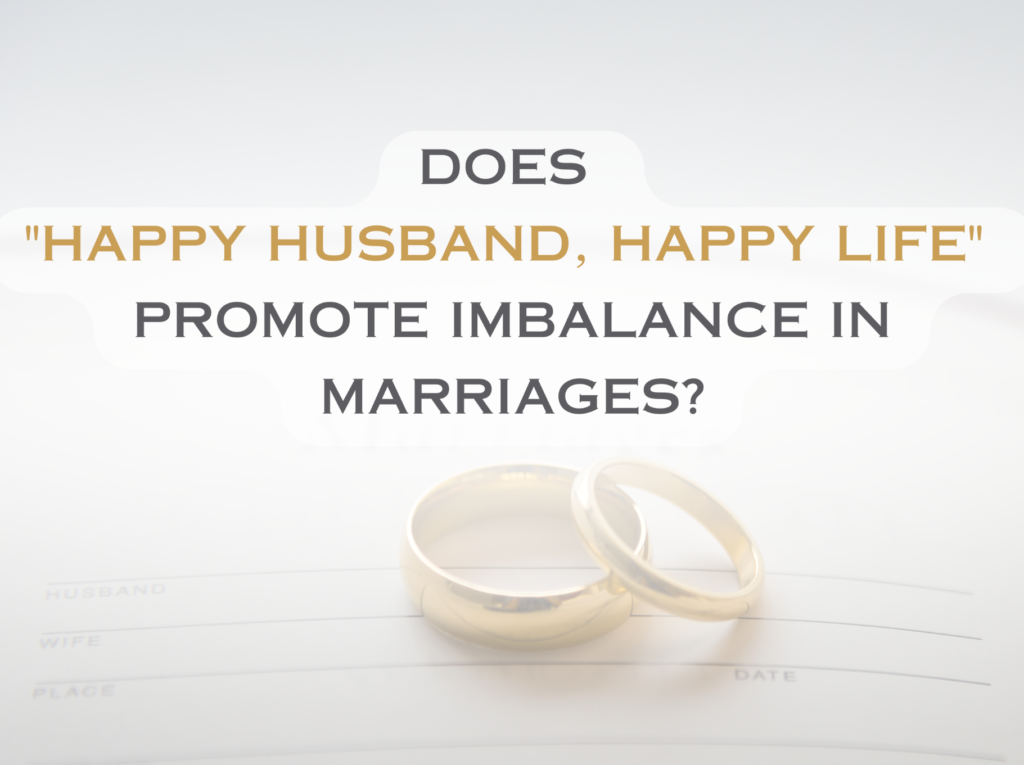Have you ever heard the age-old adage, ‘Happy husband, happy life’? This widely accepted societal norm suggests that if wives prioritize their husbands’ happiness, their lives and relationships will be more fulfilling. But in today’s landscape, where equality and mutual happiness are central tenets of healthy relationships, does this notion still hold weight? Join us as we delve into this timeless question in the following post.

“No matter where I went, I always knew my way back to you. You are my compass star.”
— Diana Peterfreund
What is a ‘Happy husband happy life’?
“Happy Husband, Happy Life” is a norm that’s been around forever, passed down through generations, and even used as a half-joking threat. But have you ever stopped to think about what it means? Sure, everyone wants a happy marriage, but could this well-meaning phrase be doing some damage?
This saying reinforces outdated gender stereotypes, similar to the ‘happy wife, happy life’ mantra. It hints at men being emotionally less resilient and in need of constant appeasement while framing women as the perpetual soothers and emotional managers. Such stereotypes are not only harmful but also inaccurate.
The origin of ‘Happy husband happy life’
The idea of a wife putting her husband’s happiness first is deeply rooted in our history and stems from various intertwined sources:
• Patriarchal Power Structures
Men have held dominant positions within the family and broader social structures throughout many societies and eras. This often positioned them as providers, protectors, and the ultimate decision-makers. Women were relegated to supportive roles, their primary duty framed as catering to their husband’s well-being.
• Religious Influence
Many religions have texts and traditions reinforcing this dynamic. The Bible’s creation story, where Eve is formed from Adam’s rib as a “helper,” is a prime example. This interpretation paints women as secondary and explicitly created to serve men, justifying a focus on ensuring their happiness.
• Hunter-Gatherer Legacy
Even before complex societies, the necessary division of labor in hunter-gatherer groups provides a foundation for this mindset. Men often focused on hunting, seen as dangerous and critical for survival. Historically viewed as less risky, women’s roles tended towards gathering and domestic tasks. This subtly built an expectation that a man’s well-being is paramount, further solidified by later social structures.
• Economic Dependence
In the past, women frequently had few options outside of marriage for survival and security. This dependence tied their well-being intrinsically to their husband’s happiness. Pleasing the spouse was not merely a social nicety but an essential means of safeguarding their quality of life.
‘Happy husband happy life’: Social norm or outdated idea for modern marriages?
A social norm is an unwritten rulebook for acting within a group or society. These norms are often so ingrained that we follow them without conscious thought. Consider women’s subtle pressures to put their career aspirations on hold when they have children. At the same time, similar expectations rarely exist for men. This illustrates how social norms about gender roles can be powerful, even unspoken.
“Happy Husband, Happy Life” reflects a deeply entrenched social norm rooted in our history. This norm dictates that a wife’s primary responsibility is her husband’s happiness. As we discussed earlier, this stems from patriarchal societies where men were dominant, and women were expected to be subservient. Hunter-gatherer traditions also play a role, subtly emphasizing the importance of male well-being for the group’s survival.
Even though many modern societies strive for equality, social norms can take time to change. The “Happy Husband, Happy Life” expectation lingers, sometimes unconsciously shaping how people view relationships. This can pressure women to put their needs aside in pursuing an outdated notion of marital harmony.
While not every society was the same, many were built on a man-centered structure. This past inequality is why the “Happy Husband, Happy Life” idea still has power, even when we want fairness today.

When ‘Happy husband happy life’ backfires: Polygamy, Affairs and Conflicts
When a relationship dynamic focuses solely on one partner’s happiness, it creates an environment where desires and needs can go unfulfilled. This imbalance breeds resentment and can lead to damaging consequences, some of which include:
• Polygamy: A Man Seeking “Happiness” Elsewhere
In some cultures where the “Happy Husband, Happy Life” ideal takes an extreme form, a husband may feel justified in seeking additional wives if he perceives that his needs aren’t fully met within his primary marriage. This stems from the idea that a man’s satisfaction is paramount, regardless of the emotional toll it takes on women within the family.
• Extramarital Affairs: The Search for Missing Fulfillment
Even in cultures where polygamy isn’t the norm, both men and women can be tempted to stray if they feel chronically neglected in their marriage. When one partner feels their role is to please without receiving equivalent consideration, that can lead to infidelity in marriage.
• Marital Conflicts: Simmering Resentment Erupts.
Bottled-up frustrations from the spouse always taking a backseat can then explode into arguments and deep relationship damage. Unmet needs and unspoken resentments can simmer beneath the surface, ultimately causing conflicts and damaging relationships.
• Emotional Burden
When the wife is solely responsible for her husband’s emotional needs in marriage, it can lead to an overwhelming emotional load and potential burnout. They may feel pressured to minimize their goals and focus on their husband’s happiness, sacrificing personal growth and ambitions.
• Marital Breakdown and Divorce
Historically, women often had little recourse if they found themselves in these situations. Social and economic dependence trapped them in unhappy marriages. While these problems still exist, there’s a crucial difference – choice. Many modern women can leave relationships that do not fulfill them or work with their partner to renegotiate the terms of their marriage.
Does the presence of choice suggest that the ‘Happy husband, happy life’ mindset is now less detrimental? Or does the enduring influence of this societal norm imply that negative consequences continue to affect many individuals just as profoundly?

Tips for finding balance with ‘Happy husband happy life’
1. The Power of Open Communication
“Sarah and Ben seemed like the picture-perfect couple. Sarah loved creating a comfortable home for her husband, while Ben excelled in his career. Yet, over time, Sarah began to feel a quiet restlessness. She loved Ben dearly, but her dreams felt increasingly distant.
One evening, Sarah found the courage to talk to Ben. She expressed her love for him and her desire for more personal fulfillment. With Ben’s support, they began having regular open conversations about their goals. Sarah explored her passions while Ben stepped up at home, creating a new rhythm that felt supportive and balanced in their marriage.
Ben’s support in encouraging Sarah to voice her needs and desires highlights that “keeping her happy” is now just as important as the “happy husband, happy life” norm.
2. Understanding and Meeting Your Spouse’s Emotional Needs
Couples must understand and meet their partner’s emotional needs. A balanced relationship prioritizes mutual well-being.
3. Compromise: Finding the middle ground
Neither the husband nor his wife should have their way all the time. You must be prepared to find the middle ground for a peaceful relationship.
4. Seek Support If Needed
Couples coaching or counseling provides a safe space to develop a thriving, long-lasting relationship if these changes feel overwhelming.
Redefining ‘Happy husband happy life
Instead of “Happy Husband, Happy Life,” why not aim for “Happy Partners, Happy Life”? Shouldn’t we focus on building a dynamic where both couples feel cherished, heard, and supported to flourish?
Picture a marriage focused on open communication, sharing the load, and celebrating each other’s successes – that sounds far healthier and more fulfilling than a one-sided approach.

Frequently Asked Questions
Q: Does prioritizing husbands’ happiness over wives contribute to an imbalance in marriages?
Yes, prioritizing one partner’s happiness over the other can lead to an imbalance in marriages. It may create a dynamic where one partner’s needs and desires consistently take precedence, resulting in resentment and dissatisfaction for the other.
Q: How does the “Happy husband happy life” mindset affect gender roles within marriages?
The “Happy husband happy life” mindset can reinforce traditional gender roles, placing the burden of maintaining marital happiness primarily on wives. This can perpetuate unequal power dynamics and limit both partners’ autonomy and fulfillment.
Q: Are specific challenges arising from adhering to the “Happy husband happy life” ideology?
Adhering to this ideology can lead to neglecting the wife’s emotional well-being and individual needs. It may also hinder open communication and collaboration between partners, as one partner’s happiness is prioritized at the expense of the other’s.
Q: How can couples address the potential imbalance caused by the “Happy husband happy life” mentality?
Couples can address this imbalance by promoting mutual respect, understanding, and communication within their relationship. They should strive for equality in decision-making and actively work to meet each other’s needs and desires. Additionally, challenging traditional gender roles and societal expectations can help create a more equitable and fulfilling marriage.
Conclusion
So, what do you think? Has ‘happy husband happy life’ passed its expiry date? Let’s drop the old-fashioned ideas about who’s responsible for keeping the marital peace. A robust and fulfilling marriage is a balancing act. It’s about recognizing that both partners’ happiness and well-being are essential.
A better term to consider should be ‘Happy couple happy life’.
Suppose you are in a relationship where your needs always take a backseat. In that case, it’s time to have that honest conversation and work towards positive changes. Your happiness matters, too!
Please share your experiences and thoughts in the comments below!
Or let’s continue the discussion on Twitter, Facebook, Instagram, or Linkedin.
If you found this post valuable, please join our newsletter. You’ll receive insightful articles, tips, and inspiration for building a more balanced and fulfilling relationship.
Thanks for reading!
